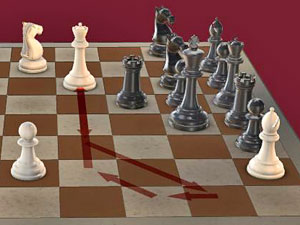Where is the white king?
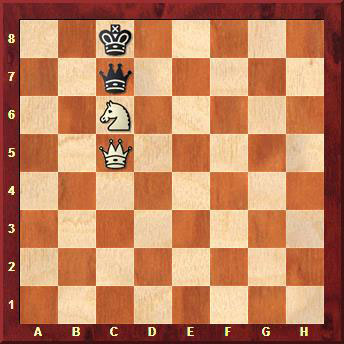
In our weekend
puzzle, which Ken Thompson thought up in 1986, when he was fooling around
with his first five-piece tablebase endings, we asked you to find the only
position on which the white king can be placed in the above position so
that White (to play) can force a win. There is really only one square that
allows this – put the white king on any other and Black is able to
force a draw. Here is the solution:

[Event "Endgame puzzle"] [Site "?"] [Date "1986.??.??"] [Round "?"] [White
"Thompson, Ken"] [Black "White to play and win"] [Result "1-0"] [SetUp
"1"] [FEN "K1k5/2q5/2N5/2Q5/8/8/8/8 w - - 0 1"] [PlyCount "17"] [EventDate
"1986.??.??"] {[%csl Ga8] The only square for the white king which turns
the position into a forced win is a8!} 1. Qf5+ Qd7 2. Na7+ Kc7 3. Qc5+
Kd8 4. Qf8+ Qe8 (4... Kc7 5. Qb8#) 5. Nc6+ Kd7+ 6. Nb8+ Kd8 7. Qd6+ Kc8
8. Nc6 {[%csl Rb8,Rd8][%cal Rd6b8, Rd6d8]} Qxc6+ (8... Qd7 9. Qb8#) 9.
Qxc6+ 1-0
Mate in 203 moves
By John Nunn
Long-range mating problems are not generally the strong point of computers,
especially if the number of moves they are required to find are counted
in dozens or over a hundred. But in spite of this it is possible to use
a computer program when solving such problems. They usually work with shorter
threats that computers can understand, and such threats can easily be found
with a chess engine. The overall long-range strategy may escape them completely,
but it is here that the human operator can jump in.
The longest dual-free direct mate problem
The longest direct mate problem was devised by the Danish composer Walther
Jörgensen, who published it in the problem magazine "Schwalbe"
in 1976 as a mate in 200 moves. In the same year André
Chéron found a small change that extended the problem to 203
moves. Subsequently there were attempts to extend Jörgensen's problem
to 210 or even 215 moves, but this came with a weakening of the black forces,
so that it was possible that White could win the position by conventional
play in a shorter number of moves.
Longer direct mate problems have been published, like a mate in 257 by
O. T. Blathy, and one by the same author in 290 moves. But these problems
all contained duals, which means that at certain points in the
solution the white continuation is not forced. In particular, many of these
very long problems involve repeated king marches by White in order to lose
a tempo. These marches have a triangulation in them at some point (for example,
Kb1-a1-a2-b1), so that it will be Black to move at the end of the march.
Generally, these triangulations involve a dual in that they can be executed
in two ways, for example Kb1-a1-a2-b1 or Kb1-a2-a1-b1. The beauty of the
Jorgensen problem is that there are no such alternatives.
This is precisely why the Jörgensen problem is so remarkable: every
single one of the 203 moves is forced (assuming optimum defence by Black),
and each white move needs to be executed in exactly the sequence given.
It is in my opinion the longest dual-free direct mate problem without
pawn promotions.
Walter Jörgensen, Die Schwalbe 1976
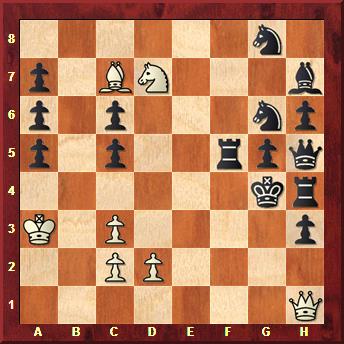
White to play and mate in 203 moves
We immediately see that due to the material superiority of the opponent
White cannot win by conventional means. He must execute a forced mating
attack. The first task, however, is to blockade the black pawn on h3 and
gain total control of the position. So let us begin [a full Javascript replay
is provided at the end of this article]:
1.Qg1+ Kf3 2.Qf1+ Kg4 (2... Ke4 3.Qd3 mate) 3.Qe2+
Rf3 4.Qe6+ Rf5 5.Bh2.
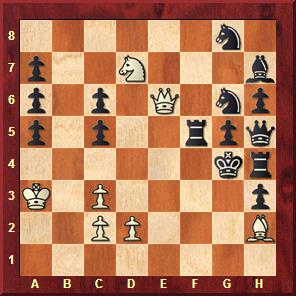
With the introductory moves White has tied down the position so that the
opponent's forces can no longer be mobilized. We take note that Black cannot
move either of his knights: if he moves the Ng6 then White mates immediately
with Ne5; the move 5...N8e7 allows 6.Qe2+ Rf3 7.Qe4+ Rf4 8.Nf6#; 5...Nf6?
just delay the end by one move: 6.Nxf6+ Kf3 7.Qe3+ Kg2 8.Qg1+ Kf3 9.Qf1#.
There is only one continuation for Black: 5...Kf3. This threatens
to release the black heavy pieces, which White must avoid at all costs.
6.Qe3+ Kg2 7.Qg1+ Kf3 8.Qf1+ Kg4 9.Qe2+ Rf3 10.Qe6+ Rf5. We will
call these five moves the "Jörgensen Manoeuvre". They have led
to the position after White's fifth move (see diagram above), but with White
to move.
What can White do with the free move? If Black had no pawns on the a and
c-files the game would soon be over: White executes the Jörgensen Manoeuvre
three times, bringing his king to d1 in the process, after which Black cannot
play ...Kf3 any more, because Qe2 would be mate. He has to move a knight
which leads to mate as described above.
You may think that White could simply go after the black pawns after each
Jörgensen Manoeuvre, but note that moving the king to a4 leaves it
open to a rook check when the black king moves to f3; and playing c3-c4
will make the white king vulnerable to rook checks on the third rank, which
it could thus no longer occupy. No, the process is much longer and more
convoluted.
11.Kb2 Kf3 12.Qe3+ Kg2 13.Qg1+ Kf3 14.Qf1+ Kg4 15.Qe2+ Rf3 16.Qe6+
Rf5 17.Kc1 Kf3 18.Qe3+ Kg2 19.Qg1+ Kf3 20.Qf1+ Kg4 21.Qe2+ Rf3 22.Qe6+ Rf5
23.Kd1

Now Black must move a pawn (23...Kf3? 24.Qe2#) 23...a4. This offers
the greatest resistance. 24.Kc1 24.Ke1? allows the a-pawn to promote.
24...Kf3 25.Qe3+ Kg2 26.Qg1+ Kf3 27.Qf1+ Kg4 28.Qe2+ Rf3 29.Qe6+ Rf5
30.Kd1 a5. After 30...a3? 31.Kc1, 37.Kb1, 43.Ka2, 49.Kxa3, 55.Kb2, 61.Kc1
White can make three king moves without the Jörgensen Manoeuver (67.Kd1
a5 68.Ke1! a4 69.Kd1) saving a total of ten moves.
31.Kc1 Kf3 32.Qe3+ Kg2 33.Qg1+ Kf3 34.Qf1+ Kg4 35.Qe2+ Rf3 36.Qe6+ Rf5
37.Kd1 a6 38.Kc1 Kf3 39.Qe3+ Kg2 40.Qg1+ Kf3 41.Qf1+ Kg4 42.Qe2+ Rf3 43.Qe6+
Rf5 44.Kd1 a3.
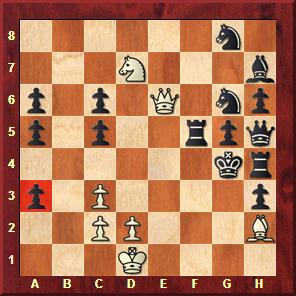
The first "lemming suicide plunge": the black pawn has had to
move to a square on which it can be safely captured – after four Jörgensen
Manoeuvres: 45.Kc1 ... 51.Kb1 ... 57.Ka2 ... 63.Kxa3.
Now the white king must return to d1 to force another pawn move: 69.Kb2
... 75.Kc1 ... 81.Kd1 a4. Now White uses the Jörgensen Manoeuvre
to shuffle his king between c1 and d1, forcing black pawn moves: 82.Kc1
... 88.Kd1 a5 89.Kc1 ... 95.Kd1 c4. Note that after the next Jörgensen,
96.Kc1 Kf3 97.Qe3+ Kg2 98.Qg1+ Kf3 99.Qf1+ ...

... Black can try 99...Ke4, since White can no longer mate with Qd3. But
100.d3+ does the job: 100...Kd5 (100...Ke3 101.Bg1+ Rf2 102.Qxf2#)
101.Qxf5+ Ne5 102.Qxe5#.
So: 99...Kg4 100.Qe2+ Rf3 101.Qe6+ Rf5 102.Kd1
c5 103.Kc1 Kf3 104.Qe3+ Kg2 105.Qg1+ Kf3 106.Qf1+ Kg4 [106...Ke4? Black
can try to use the free c6 square by 106...Ke4?, but this proves in vain
after 107.d3+ Kd5 108.Qxf5+ Kc6 109.Qe6+ Kb7 110.Qb6+ Kc8 111.Qc7#.]. 107.Qe2+
Rf3 108.Qe6+ Rf5

White still cannot pick up the pawn on a4: 109.Kb2? Kf3 110.Qe3+ Kg2 111.Qg1+
Kf3 112.Qf1+ Kg4 113.Qe2+ Rf3 114.Qe6+ Rf5 115.Ka3 Kf3 116.Qe3+ Kg2 117.Qg1+
Kf3 118.Qf1+ Kg4 119.Qe2+ Rf3 120.Qe6+ Rf5 121.Kxa4 Kf3 122.Qe3+ Kg2 123.Qg1+
Kf3 124.Qf1+ Ke4! 125.Qe1= (125.Qxc4+ Kf3-+ The queen is pinned!;
125.d3 Ke3–+).
109.Kd1 a3 110.Kc1 ... 116.Kb1 Kf3 117.Qe3+ Kg2 118.Qg1+ Kf3
119.Qf1+ Ke4!
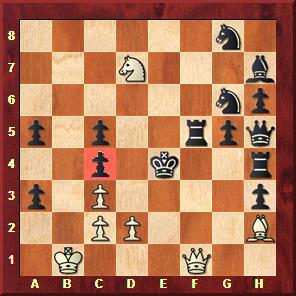
This forces White to capture the pawn on c4, giving the pawn c5 an extra
move. 120.Qxc4+ [120.d3+? Ke3!–+] 120...Kf3 121.Qf1+ Kg4
122.Qe2+ Rf3 123.Qe6+ Rf5 124.Ka2 ... 130.Kxa3 ... 136.Kb2 ... 142.Kc1 ...
148.Kd1 a4 149.Kc1 ... 155.Kd1 c4 156.Kc1 ... 162.Kd1 a3 163.Kc1 ... 169.Kb1
... 175.Ka2 ... 181.Kxa3 ... 187.Kb2 Kf3 188.Qe3+ Kg2 189.Qg1+ Kf3
190.Qf1+ Ke4. Black extends the solution by two moves. 191.Qxc4+
Kf3 192.Qf1+ Kg4 193.Qe2+ Rf3 194.Qe6+ Rf5 195.Kc1 Kf3 196.Qe3+. The
Jörgensen Manoeuvre is executed for the last time. 196...Kg2 197.Qg1+
Kf3 198.Qf1+ Kg4 199.Qe2+ Rf3 200.Qe6+ Rf5 201.Kd1

The final zugzwang. 201...N8e7 [201...Kf3 202.Qe2#] 202.Nf6+
Kf3 203.Qe2#.

[Event "?"] [Site "?"] [Date "1976.??.??"] [Round "?"] [White "Jorgensen,
W."] [Black "Mate in 203 moves"] [Result "1-0"] [Annotator "Nunn,John"]
[SetUp "1"] [FEN "6n1/p1BN3b/p1p3np/p1p2rpq/6kr/K1P4p/2PP4/7Q w - - 0
1"] [PlyCount "405"] [EventDate "1976.??.??"] 1. Qg1+ {Leading to mate
in 203! The longest dual-free direct-mate problem without promoted pieces.
All notes are by Dr John Nunn.} Kf3 2. Qf1+ Kg4 (2... Ke4 3. Qd3#) 3.
Qe2+ Rf3 4. Qe6+ Rf5 5. Bh2 {Blocking the enemy forces. The next black
move is forced.} Kf3 (5... N6e7 $2 6. Ne5#) (5... N8e7 $2 6. Qe2+ Rf3
7. Qe4+ Rf4 8. Nf6#) (5... Nf6 $2 6. Nxf6+ Kf3 7. Qe3+ Kg2 8. Qg1+ Kf3
9. Qf1#) 6. Qe3+ Kg2 7. Qg1+ Kf3 8. Qf1+ Kg4 9. Qe2+ Rf3 10. Qe6+ Rf5
{The 'Jörgensen Manoeuver', which repeats the position after White's 5th
move, with a free move for White. If Black had no pawn moves he would
soon be mated. Note that White cannot move his king to a4 because of ...Kf3+}
11. Kb2 Kf3 12. Qe3+ Kg2 13. Qg1+ Kf3 14. Qf1+ Kg4 15. Qe2+ Rf3 16. Qe6+
Rf5 17. Kc1 Kf3 18. Qe3+ Kg2 19. Qg1+ Kf3 20. Qf1+ Kg4 21. Qe2+ Rf3 22.
Qe6+ Rf5 23. Kd1 {Now Black must move a pawn (23...Kf3? 24.Qe2#)} a4 {This
offers the greatest resistance.} 24. Kc1 {24.Ke1? allows the a-pawn to
promote} Kf3 25. Qe3+ Kg2 26. Qg1+ Kf3 27. Qf1+ Kg4 28. Qe2+ Rf3 29. Qe6+
Rf5 30. Kd1 a5 {After 30...a3? 31.Kc1, 37.Kb1, 43.Ka2, 49.Kxa3, 55.Kb2,
61.Kc1 White can make three king moves without the Jörgensen Manoeuver
(67.Kd1 a5 68. Ke1! a4 69.Kd1) saving a total of 10 moves.} 31. Kc1 Kf3
32. Qe3+ Kg2 33. Qg1+ Kf3 34. Qf1+ Kg4 35. Qe2+ Rf3 36. Qe6+ Rf5 37. Kd1
a6 38. Kc1 Kf3 39. Qe3+ Kg2 40. Qg1+ Kf3 41. Qf1+ Kg4 42. Qe2+ Rf3 43.
Qe6+ Rf5 44. Kd1 a3 {[%csl Ra3]} 45. Kc1 Kf3 46. Qe3+ Kg2 47. Qg1+ Kf3
48. Qf1+ Kg4 49. Qe2+ Rf3 50. Qe6+ Rf5 51. Kb1 Kf3 52. Qe3+ Kg2 53. Qg1+
Kf3 54. Qf1+ Kg4 55. Qe2+ Rf3 56. Qe6+ Rf5 57. Ka2 Kf3 58. Qe3+ Kg2 59.
Qg1+ Kf3 60. Qf1+ Kg4 61. Qe2+ Rf3 62. Qe6+ Rf5 63. Kxa3 {Now the wK must
return to d1 to force another pawn move} Kf3 64. Qe3+ Kg2 65. Qg1+ Kf3
66. Qf1+ Kg4 67. Qe2+ Rf3 68. Qe6+ Rf5 69. Kb2 Kf3 70. Qe3+ Kg2 71. Qg1+
Kf3 72. Qf1+ Kg4 73. Qe2+ Rf3 74. Qe6+ Rf5 75. Kc1 Kf3 76. Qe3+ Kg2 77.
Qg1+ Kf3 78. Qf1+ Kg4 79. Qe2+ Rf3 80. Qe6+ Rf5 81. Kd1 a4 82. Kc1 Kf3
83. Qe3+ Kg2 84. Qg1+ Kf3 85. Qf1+ Kg4 86. Qe2+ Rf3 87. Qe6+ Rf5 88. Kd1
a5 89. Kc1 Kf3 90. Qe3+ Kg2 91. Qg1+ Kf3 92. Qf1+ Kg4 93. Qe2+ Rf3 94.
Qe6+ Rf5 95. Kd1 c4 96. Kc1 Kf3 97. Qe3+ Kg2 98. Qg1+ Kf3 99. Qf1+ {[%cal
Rf3e4]} Kg4 (99... Ke4 {Now White cannot mate with Qd3, but} 100. d3+
{does the job:} Kd5 (100... Ke3 101. Bg1+ Rf2 {It is important that the
wK is on c1, otherwise the bK would find a safe spot on d2.} 102. Qxf2#)
101. Qxf5+ Ne5 102. Qxe5#) 100. Qe2+ Rf3 101. Qe6+ Rf5 102. Kd1 c5 103.
Kc1 Kf3 104. Qe3+ Kg2 105. Qg1+ Kf3 106. Qf1+ Kg4 (106... Ke4 $2 {Black
can try to use the free c6 square, but in vain} 107. d3+ Kd5 108. Qxf5+
Kc6 109. Qe6+ Kb7 110. Qb6+ Kc8 111. Qc7#) 107. Qe2+ Rf3 108. Qe6+ Rf5
{[%csl Ra4]} 109. Kd1 (109. Kb2 $2 {White still cannot pick up the pawn
on a4} Kf3 110. Qe3+ Kg2 111. Qg1+ Kf3 112. Qf1+ Kg4 113. Qe2+ Rf3 114.
Qe6+ Rf5 115. Ka3 Kf3 116. Qe3+ Kg2 117. Qg1+ Kf3 118. Qf1+ Kg4 119. Qe2+
Rf3 120. Qe6+ Rf5 121. Kxa4 Kf3 122. Qe3+ Kg2 123. Qg1+ Kf3 124. Qf1+
Ke4 $1 125. Qe1+ (125. Qxc4+ Kf3 $19 { The queen is pinned!}) (125. d3+
Ke3 $19)) 109... a3 110. Kc1 Kf3 111. Qe3+ Kg2 112. Qg1+ Kf3 113. Qf1+
Kg4 114. Qe2+ Rf3 115. Qe6+ Rf5 116. Kb1 Kf3 117. Qe3+ Kg2 118. Qg1+ Kf3
119. Qf1+ Ke4 $1 {This forces White to capture the pawn on c4, giving
the pawn c5 an extra move} 120. Qxc4+ (120. d3+ $2 Ke3 $1 $19) 120...
Kf3 121. Qf1+ Kg4 122. Qe2+ Rf3 123. Qe6+ Rf5 124. Ka2 Kf3 125. Qe3+ Kg2
126. Qg1+ Kf3 127. Qf1+ Kg4 128. Qe2+ Rf3 129. Qe6+ Rf5 130. Kxa3 Kf3
131. Qe3+ Kg2 132. Qg1+ Kf3 133. Qf1+ Kg4 134. Qe2+ Rf3 135. Qe6+ Rf5
136. Kb2 Kf3 137. Qe3+ Kg2 138. Qg1+ Kf3 139. Qf1+ Kg4 140. Qe2+ Rf3 141.
Qe6+ Rf5 142. Kc1 Kf3 143. Qe3+ Kg2 144. Qg1+ Kf3 145. Qf1+ Kg4 146. Qe2+
Rf3 147. Qe6+ Rf5 148. Kd1 a4 149. Kc1 Kf3 150. Qe3+ Kg2 151. Qg1+ Kf3
152. Qf1+ Kg4 153. Qe2+ Rf3 154. Qe6+ Rf5 155. Kd1 c4 156. Kc1 Kf3 157.
Qe3+ Kg2 158. Qg1+ Kf3 159. Qf1+ Kg4 160. Qe2+ Rf3 161. Qe6+ Rf5 162.
Kd1 a3 163. Kc1 Kf3 164. Qe3+ Kg2 165. Qg1+ Kf3 166. Qf1+ Kg4 167. Qe2+
Rf3 168. Qe6+ Rf5 169. Kb1 Kf3 170. Qe3+ Kg2 171. Qg1+ Kf3 172. Qf1+ Kg4
173. Qe2+ Rf3 174. Qe6+ Rf5 175. Ka2 Kf3 176. Qe3+ Kg2 177. Qg1+ Kf3 178.
Qf1+ Kg4 179. Qe2+ Rf3 180. Qe6+ Rf5 181. Kxa3 Kf3 182. Qe3+ Kg2 183.
Qg1+ Kf3 184. Qf1+ Kg4 185. Qe2+ Rf3 186. Qe6+ Rf5 187. Kb2 Kf3 188. Qe3+
Kg2 189. Qg1+ Kf3 190. Qf1+ Ke4 {Black extends the solution by two moves.}
191. Qxc4+ Kf3 192. Qf1+ Kg4 193. Qe2+ Rf3 194. Qe6+ Rf5 195. Kc1 Kf3
196. Qe3+ {The Jörgensen manoeuvre is executed for the last time.} Kg2
197. Qg1+ Kf3 198. Qf1+ Kg4 199. Qe2+ Rf3 200. Qe6+ Rf5 201. Kd1 N8e7
(201... Kf3 202. Qe2#) 202. Nf6+ Kf3 203. Qe2# {Note that every single
white move in this problem was forced!} 1-0
Solving in Style
The above article was written by John Nunn for a German computer chess
magazine I was editing at the time. It was not extracted from one of my
all-time favourite chess books, though it would have been well suited to
be part of it.
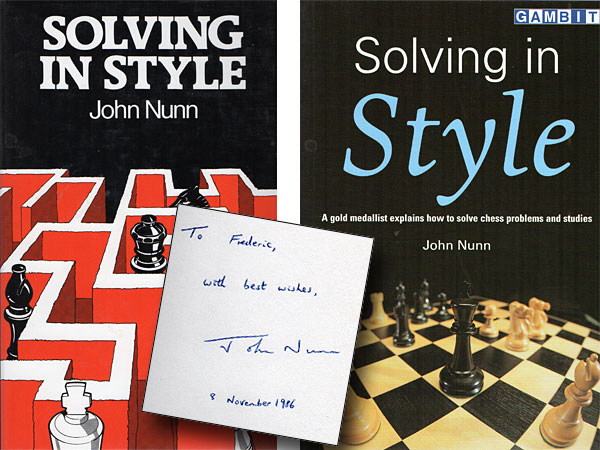
The book was given to me in late 1986 by the author, as you can see from
the dedication above. On the left is the original hardcover by George Allen
& Unwin, on the right the 2002 reprint by Gambit, which I am pleased
to see is still
available for purchase, for £9.50/$14.95/€12.85.
In this book, John Nunn (who recently
turned 60), a top-class grandmaster and also one of the world's finest
solvers, explains the methods by which chess problems and studies can be
tackled. The logical and creative methods advocated, while targeted at the
solving of composed positions, may also help players find startling tactical
solutions in their games. Solving in Style also constitutes an
entertaining and insightful introduction to the world of problems and studies.
"Nunn does an excellent job of explaining the special rules of this
parallel universe, but where he is likely to gain the most converts is in
the field of chess studies," wrote John Donaldson. "Many of these
studies look sufficiently 'game-like' that the over-the-board player will
have no trouble appreciating the beauty and ingenuity involved. Highly recommended."
I cannot tell you how many hours I have spent with this book, which Jon
Speelman with a penchant for Cockney
rhyming slang referred to as "Dissolving in Bile". At the
time I would use a chess board, soon thereafter transferring the positions
into chess computers and problem solving programs. I do hope that someday
John will make the problems in the book available in PGN – how many
hours we would spend playing through the solutions on the GUI of a modern
chess program.
Frederic Friedel
